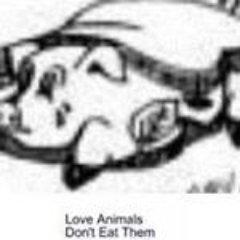20 Of Many Ways Chickens Die
Folder:
A Fellow Creature 1. In San Diego baby males were sent alive through a wood chipper.
2. In Iowa on a conveyor belt they are sent alive into a crusher
and come out as paste. http://hatchery.mercyforanimals.org
3. On many farms they are strangled to death. http://upc-online.org
4. In many places they are dropped into eviscerators, metal tubs full of swirling knives.
5. At one major fast food chain, some chickens died of scalding while alive.
6. On loading docks at many private corporations, airlines, USPS and other places
the chicks are crushed in flimsy cardboard boxes, Senator Grassley
having removed all the humane protections and having classified these chick males
as commercial mail. His bill was signed into law. Recently as the US mail was slowed
and overtime limited by the Republican administration, many more animals were dying
on the loading docks.
7. Some die of thirst
8. Others in factory farm electricity outages die of freezing or of baking.
9. Some die in ritual religious sacrifices.
10. Some are dropped into the street as boxes slip from cranes, for instance in Salisbury Maryland. These are run over by cars bikes buses and trucks.
11. At some universities, corporations, and tax supported USDA torture centers
they are researched upon.
12 Most are clipped upside down onto conveyor belts and their throats slit.
13. Some chickens molt too soon. Their feathers drop away and they freeze
to death.
14. On farms, helpless chickens caged and captive, are prey to foxes, coyotes, etc
who kill them.
15. Transported in trains, trucks, they are often crushed in traffic accidents.
16. Captive in metal cages inside metal factory farms, they have often been crushed by hurricanes and tornadoes. Some have been bulldozed into the ground
alive and covered with dirt.
17 They die of many diseases from overcrowding (9 to a 3 ft by 1 ft cage e.g.). Leukemia is the same disease as leukosis except that chickens contractit. They can contract coronaviruses
18 They sometimes die of being pecked by other chickens in their sardine in a can existences.
19. Sometimes fertilized eggs of chickens are included in egg cartons. Cooks have found their skillets full of beaks and claws of partially developed birds.
20. Some factory farms breed them to be topheavy with more meat. They are injured often by the inability to stand.
How do chickens suffer?
1 When they are debeaked, their tongues sometimes catch in the debeaker.
2. When they are caged in factory farms, they spend their lives unable in
many instances to spread their wings. Sometimes nine are crammed into
a one foot by three foot cage.
3. Sometimes their claws grow around the wire mesh on which they stand
and they are unable to move.
“The chickens try to hide their heads from you by sticking them under the wing of the chicken next to them on the slaughter line. You can tell by their looking at you, they’re scared to death” -United Poultry Concerns-
Many have found they make wonderful pets.
After reading this, many would conclude the best way to prevent this
is to stop giving butchers a profit motive for slaughter by no longer eating chickens or eggs.
Many Republican attorneys general sued the states of California and Massachusetts which had adopted laws for bigger cages in which the birds could spread their wings and turn around. Senator Hawley was a coordinator of one of the lawsuits. Both efforts to interfere with humane legislation were defeated. (There are several reasons to oppose each of the duopoly political parties.)
Eggs account for half of the annual food poisoning fatalities. Eggs have an average 250 to 300 milligrams of brain, heart and other artery blocking fat. When a chicken has cancer, it is called leukosis instead of leukemia, but one can contract cancer by eating an infected chicken. Some slaughterhouses practice excising a visible tumor and sending the rest of the cadaver through. There is no testing for cancer or other diseases in birds. It is only after people get sick and/or die that recalls occur. Salmonella, listeria are 2 of the diseases of chickens. Each egg takes many gallons of water in production.
The USDA under Reagan doubled the speed of the conveyor belts making inspection difficult and causing multiplied accidents and digit amputations to workers. A recent attempt of the USDA yet again to increase the inspection line speed even more was foiled.
http://pcrm.org Of PCRM’s 150,000 members, 12,000 are vegan, vegetarian or vegan supporting physicians.
